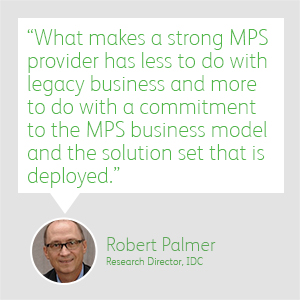 The office document and printing landscape is changing dramatically, and there are many facets impacting the implementation of managed print services (MPS). Gaining a firm grasp of these issues is key to developing a successful services practice.
The office document and printing landscape is changing dramatically, and there are many facets impacting the implementation of managed print services (MPS). Gaining a firm grasp of these issues is key to developing a successful services practice.
There are probably as many different definitions of MPS as there are companies who provide the service. In its early stages, MPS was viewed simply as a means of managing an existing fleet of output devices under a single service contract.
Today, MPS involves much more than managing and servicing hardcopy output devices. Indeed, MPS has evolved to include the ongoing optimization of the printing environment and further improvements to complementary business processes. MPS is broadening in scope and complexity, putting greater emphasis on the need to extend your services offering beyond the typical print-centric approach.
As MPS continues to move down market, it is opening up to a whole new class of service providers. Most traditional office equipment dealers and resellers have adopted MPS programs. Retail stores, computer dealers, IT distributors, and supplies resellers also offer full-blown MPS programs.
Meanwhile, channel providers that previously had little desire to sell printers or MFPs—IT resellers and managed service providers (MSPs)—are now getting into the game to expand their services portfolio and drive incremental revenue. It should be noted that no specific channel is inherently better at delivering and supporting an MPS offering. What makes a strong MPS provider has less to do with legacy business and more to do with a commitment to the MPS business model and the solution set that is deployed.
Collision Course
Why does this matter? Simple: the office printing market is under attack and deep in the midst of transformative change. In the enterprise segment, businesses are focused primarily on reducing print and print-related expenses, fostered by the continued migration to managed print services. Equipment sales and print volumes in the enterprise are declining steadily. The SMB sector is now the prime opportunity for growth, which means increased competition and tighter margins.
Meanwhile, overall market maturity is driving significant convergence in the types of products now serving the customer. The historical lines that used to separate traditional copiers and printers no longer exist. Today, all hardware vendors are pursuing a blended A3/A4 product strategy designed to protect their base. Traditional printer companies are now actively targeting the A3 market with both A3 and A4 products, while traditional copier vendors are all pursuing A4 printer and MFP strategies.
These trends have fueled significant upheaval in the channel. The traditional channels that have served separate sides of the organization (procurement and facilities management) now overlap in a variety of ways. Meanwhile, the historical business models are also colliding. Everyone is fighting for new customers and new pages and the distinct lines between customer engagement, A3 versus A4, contractual versus transactional, have all melted away.
Driving Disruption
This collision of channels and business models will ultimately lead to continued market consolidation. The office printing market is primed for disruption. The question is: are you positioning your business to lead that disruption? It is not an easy question to answer, primarily because disruption is typically not led from within.
Incumbent market participants typically struggle to drive innovation into mature markets because they rely so heavily on existing methodologies and historical business models.
In a typical B2B market, transformation occurs slowly, and that has certainly been the case when it comes to office printing. The “paperless office” has been predicted for quite some time, but despite significant advancements in the digital ecosystem paper remains entrenched in many business processes.
According to IDC’s U.S. Printer Page Volume Forecast, 2016–2020, total print volumes are expected to decline at a CAGR of -1.0% over the next five years. Meanwhile, printing remains a large opportunity, with 1.3 trillion printed pages projected in 2017.
Nevertheless, there is risk of developing a false sense of security when competing within the “long tail” of a slowly maturing business. The risk lies in focusing so intently on protecting existing turf that you become vulnerable to competitors who are not shackled with those same requirements. These new competitors will offer a differentiated value proposition by leveraging innovative technologies and solutions and promoting entirely new print consumption models.
Best Practices for Differentiation
To adequately address these ongoing threats, channel partners should consider the following as best practices for establishing long-term viability in the market for contractual print services:
- Pursue a differentiated, customer-centric approach. Service provider capabilities and go-to-market strategies are all quite similar. Communicating a compelling value proposition focused on customer needs is critical in a mature market.
- Promote a holistic approach to help organizations drive better business outcomes and support strategic business objectives. Lines have blurred between MPS, document management, workflow automation, and managed services. Differentiation can be found by focusing on other components of the IT stack: mobility, security, applications, cloud computing, and data analytics.
- Develop professional services capabilities around both horizontal and industry-specific document processes. This means having the business process and vertical expertise to understand a customer’s environment and pain points and then craft the best combination of technology and services to meet real customer requirements.
- Embrace an open platform solutions ecosystem and strategy. Most document solutions and workflow engagements require integration with other proprietary business systems, and there is almost always a need for some level of customization. Moving toward an open solutions ecosystem will help ensure broader support for proprietary software and enables providers to more adequately address the evolving needs of the customer’s existing infrastructure.
- Develop a strong play around IT services and the blending of IT and print. Channel partners with expertise in IT services have a distinct advantage when it comes to integrating solutions for intelligent capture, document workflow, and device/content security.
- Promote best practices around scalability and replicability. The ability to scale vertical-specific solutions and services represents significant upside for channel partners.
- Focus on extending cloud services offerings to drive customer engagement and simplify program deployment. Virtualized MPS models based on a standardized technology stack will open up new customers and reduce barriers to entry within the SMB segment.
In a mature market, differentiation is difficult to achieve. Success will come to those channel partners who are able to strengthen customer relationships by moving beyond simple vendor status to become a preferred provider.
In the office printing market, this will hinge on your ability to address customer pain points by becoming more deeply integrated into those business processes that are critical to customer operations.
The key to building a successful MPS practice for the future lies in developing service excellence, strong expertise in digital workflow, innovation and flexibility in print consumption models, and the ability to layer in additional professional and managed services. Focusing on these areas and following the best practices as described should provide a good head start.
For tips on how to leverage intelligent workflow solutions to enhance the value of your overall MPS program, read How to Leverage MPS to Better Serve Your Customers.
Learn more about Xerox Partner Print Services
Learn more about adding managed print services to your portfolio and find out about becoming accredited to sell Xerox Partner Print Services on the Xerox Global Partner Portal.
 Become a Xerox Channel Partner
Become a Xerox Channel Partner
Contact your Xerox account manager, or review the Xerox Global Partner Program and apply to become a Xerox channel partner today, to find out how we will help grow your business.
Join our Xerox Channel Partners LinkedIn Community
Looking for more marketing tips and insights from Xerox Agents, Concessionaires, and Document Technology partners from across the globe? Join our private Xerox Channel Partners LinkedIn Group to connect and discuss topics like these with your peers.
Subscribe to the Channel Partner Connection and receive email updates when we publish a new article.[wysija_form id=”1″]



